A Visit to North Korea, Part 5
The most tantalizing mystery about North Korea is its people. How do they live their lives, and what do they really think? Their belief system seems so alien, so isolated from all we know about the rest of the world, we wonder whether they have any sense of the disconnect or not – and if so, what they make of it.
Ever since I returned from my trip to the DPRK last year, one of the first questions friends always ask me is whether we ever had the chance to talk or interact with regular people there. The short answer is no. North Korea is not the kind of place where any foreigner – even the ones stationed there for months or years on diplomatic assignment – can just walk up and chat with a typical person on the street, or swing by a local pub for a round with the locals. To even attempt to do so would be courting real trouble – for the unwelcome foreigner, perhaps, but far more seriously for the hapless Korean counterpart who would fall under immediate suspicion of being a spy or worse.
It’s a strange isolating feeling, visiting a country where nobody can talk to you, except your guides — and even they tend to be pretty cagey. As our bus passed through the streets of Pyongyang, taking us from one officially sanctioned tourist site to the next, we craned our necks to catch glimpses of what might or might not be typical daily life outside the window. Pyongyang, we knew, is hardly typical. The country’s capital is a showcase, filled with grand statues of godlike leaders and fearless patriots, imposing monuments – such as the oversized replica of the Arc de Triomphe that greets you on the way in from the airport — and vast open plazas devoted to celebrating the State. There is no such thing as a Pyongyang “native.” Its population, carefully controlled at 2 million, is selected from the most politically loyal and useful citizens all across the country, and is subject to regular turnover. After the army, of course, residents receive the best food and housing in the country, and priority access to fuel and electricity.
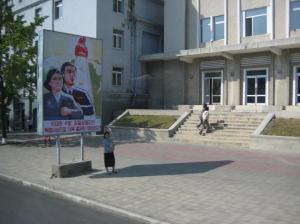 It may seem disappointing then, that aside from its monuments, Pyongyang looks a lot like an obscure provincial city in China – the kind laid out in the Mao era to site factories out in the back of beyond. The living quarters, set out row on endless row along broad empty boulevards, are square concrete apartment blocks. They are relentlessly grey and, up close, somewhat grimy. If you look into the windows, you can see that every single room – without exception, in both offices and homes — has dual portraits of Kim Il-Sung and his son Kim Jong-Il prominently hung on the wall. Pedestrians are orderly and relatively few in number, especially compared to chaotic China, and most appear to be Party professionals going about their business in simple but neat attire. Public areas are kept extremely clean, but I did see some people, including children, in ragged clothing gathered around what looked like improvised campfires in a few of the lawns next to intersections. The only signs along the street were propaganda billboards in hammer-and-sickle “socialist realism” style, extolling the efforts of the workers, the vigilance of the military, and the farseeing vision of their leaders.
It may seem disappointing then, that aside from its monuments, Pyongyang looks a lot like an obscure provincial city in China – the kind laid out in the Mao era to site factories out in the back of beyond. The living quarters, set out row on endless row along broad empty boulevards, are square concrete apartment blocks. They are relentlessly grey and, up close, somewhat grimy. If you look into the windows, you can see that every single room – without exception, in both offices and homes — has dual portraits of Kim Il-Sung and his son Kim Jong-Il prominently hung on the wall. Pedestrians are orderly and relatively few in number, especially compared to chaotic China, and most appear to be Party professionals going about their business in simple but neat attire. Public areas are kept extremely clean, but I did see some people, including children, in ragged clothing gathered around what looked like improvised campfires in a few of the lawns next to intersections. The only signs along the street were propaganda billboards in hammer-and-sickle “socialist realism” style, extolling the efforts of the workers, the vigilance of the military, and the farseeing vision of their leaders.
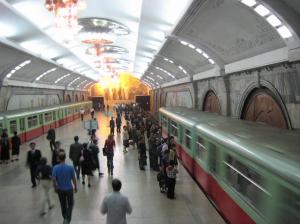 One of the few chances we had to get off our bus and “mingle,” as it were, was our visit to Pyongyang’s subway system. This is a standard stop on all tours, since for some reason the North Korean authorities are inordinately proud of this marvel of industrial-age technology. I’m guessing, from its resemblance to the Moscow subway, that this was a gift from the Russians. It was, at the very least, inspired by them. Like Moscow’s, it’s something halfway between a nuclear bomb shelter and a cathedral. After descending one of the longest escalators I’ve ever seen, you are greeted by a gilt mosaic of Kim Il-Sung, surrounded by a throng of happy followers, waving to you from the other end of a cavernous hall. Glittering chandeliers hang from the white marble ceiling, while frescos of joyful Koreans cover the walls. The subway cars themselves are rickety wooden trams, probably the original rolling stock. Passengers, directed by female conductors in smart blue uniforms using semaphore flags, move on and off with a purpose. Onboard the cars, which we rode to the next station, dual portraits of the two Kims stare down from their perch above the connecting door. Big Brother is always watching.
One of the few chances we had to get off our bus and “mingle,” as it were, was our visit to Pyongyang’s subway system. This is a standard stop on all tours, since for some reason the North Korean authorities are inordinately proud of this marvel of industrial-age technology. I’m guessing, from its resemblance to the Moscow subway, that this was a gift from the Russians. It was, at the very least, inspired by them. Like Moscow’s, it’s something halfway between a nuclear bomb shelter and a cathedral. After descending one of the longest escalators I’ve ever seen, you are greeted by a gilt mosaic of Kim Il-Sung, surrounded by a throng of happy followers, waving to you from the other end of a cavernous hall. Glittering chandeliers hang from the white marble ceiling, while frescos of joyful Koreans cover the walls. The subway cars themselves are rickety wooden trams, probably the original rolling stock. Passengers, directed by female conductors in smart blue uniforms using semaphore flags, move on and off with a purpose. Onboard the cars, which we rode to the next station, dual portraits of the two Kims stare down from their perch above the connecting door. Big Brother is always watching.
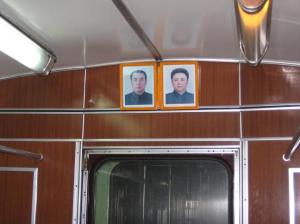 A map on the wall of the next station depicts a rather extensive subway network, with several stations scattered across Pyongyang. Several South Koreans I know are adamant that the entire thing is a sham, a Potemkin Village that consists of just two stations, and even those just for show. The “riders,” according to them, are all actors posing for tourists. They swear they have actually seen people get off one train and get right back on heading the opposite direction, in an infinite loop. From what I saw, I can’t say whether this is true or not, but it sounds a bit outlandish to me. It might well be true that there aren’t actually that many stops, and that the others stations aren’t anywhere near as fancy. But to run the whole thing just to impress foreigners … well, that would be pathetic, because it’s just not that impressive.
A map on the wall of the next station depicts a rather extensive subway network, with several stations scattered across Pyongyang. Several South Koreans I know are adamant that the entire thing is a sham, a Potemkin Village that consists of just two stations, and even those just for show. The “riders,” according to them, are all actors posing for tourists. They swear they have actually seen people get off one train and get right back on heading the opposite direction, in an infinite loop. From what I saw, I can’t say whether this is true or not, but it sounds a bit outlandish to me. It might well be true that there aren’t actually that many stops, and that the others stations aren’t anywhere near as fancy. But to run the whole thing just to impress foreigners … well, that would be pathetic, because it’s just not that impressive.
I did find it a bit odd, though, how all the other subway riders – including schoolchildren – resolutely ignored us, as though we were invisible. You’d think they would show a little bit of curiosity, but they didn’t even give us a glance. It hardly proves they were all actors, however, because the same was true of the passersby along the sidewalk when we finally resurfaced to street level. It was as though they had seen so many foreigners they were bored by us, which can hardly be the case. Perhaps they just figure it’s safer to pretend not to notice.
Nearly everyone who passed by had a red plastic badge on their lapel, usually a star or flag with a tiny picture of Great Leader Kim Il-Sung on it. While some of the shops set aside for tourists sold similar badges as souvenirs, these were the real thing. They can’t be bought, they have to be earned. The precise type of Kim badge you wear – differences which can barely be distinguished by Western eyes – signifies your place in the North Korean pecking order. And you’d better take care of it. Lose your Kim badge and you’d really find yourself in hot water. It’s considered a personal insult to the Great Leader – as is folding a newspaper over a picture of either Kim, or throwing such an image into the wastepaper basket. Before embarking on our journey, we were warned that to do either, even inadvertently, would give great offense.
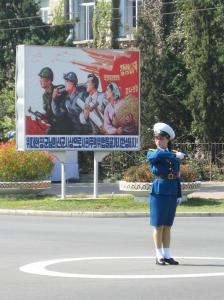 In sharp contrast to China even today, few people in Pyongyang ride bicycles. Road traffic is relatively sparse, but I was surprised by the number of expensive-looking cars on the street. I had expected more East Bloc clunkers, but instead saw plenty of sleek new sedans, jeeps, and SUVs. Obviously somebody has cash and connections. Who needs an old subway anyhow?
In sharp contrast to China even today, few people in Pyongyang ride bicycles. Road traffic is relatively sparse, but I was surprised by the number of expensive-looking cars on the street. I had expected more East Bloc clunkers, but instead saw plenty of sleek new sedans, jeeps, and SUVs. Obviously somebody has cash and connections. Who needs an old subway anyhow?
Hardly any intersection in Pyongyang has traffic lights. Instead, traffic is directed in person by members of one of the DPRK’s most hallowed institutions, the capital’s all-female corps of traffic police. Like the flight attendants on Singapore Airlines, the Pyongyang traffic guards are selected on the basis of beauty – at least according to North Korean standards, since to us they looked pretty severe. They stand for hours in the middle of each and every crossroads, in their crisp blue drill uniforms, spotless white gloves, and reflective power sunglasses, waving through cars with precision moves that would put the Queen’s guards at Buckingham Palace to shame. Our North Korean guides seemed to have boundless admiration for these beauties, although I’m not sure they get asked on many dates. Then again, they are less scary than the girls with the swords at the Mass Games.
At one point, our bus stopped near a city intersection so we could pile out and take pictures of the traffic girl on duty. This was actually one of the few chances we had to just stand on a typical street corner and people watch. At this corner, like many others we had passed, there was a little blue-and-white canvass kiosk that sold what appeared to be soft drinks. Because we had general permission to photograph the traffic girl and her environs, I snapped a photo of the kiosk, which I thought was a pretty interesting slice of Pyongyang life. Mr. Anxious (the more shy and easily flustered of our two minders) was appalled. He didn’t make me erase the shot, but he admonished me: “Take photos of good things, not bad things.”
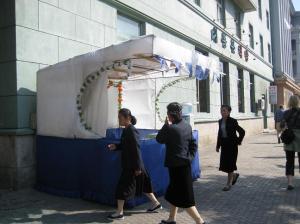 I tried to explain to him that I didn’t think the kiosk was a “bad thing.” We have hotdog stands in New York that are kind of similar, I told him, and tourists take photos of them. It’s not a symbol of poverty, people are just curious how other people live. And to tell the truth, it wasn’t like the Pyongyang kiosks looked that bad or anything, they were just different. Mr. Anxious nodded; he knew I meant no harm. But still, he beseeched me, “Take pictures of good things, not bad things.” (I made it up to him at our next stop, where I made a great show of photographing a monumental fountain with sculptures of nymph-like dancers around it. I showed him the photo on the digital screen and asked “This is a good thing, right?” With a visible sigh of relief, he replied, “Yes, good thing.”
I tried to explain to him that I didn’t think the kiosk was a “bad thing.” We have hotdog stands in New York that are kind of similar, I told him, and tourists take photos of them. It’s not a symbol of poverty, people are just curious how other people live. And to tell the truth, it wasn’t like the Pyongyang kiosks looked that bad or anything, they were just different. Mr. Anxious nodded; he knew I meant no harm. But still, he beseeched me, “Take pictures of good things, not bad things.” (I made it up to him at our next stop, where I made a great show of photographing a monumental fountain with sculptures of nymph-like dancers around it. I showed him the photo on the digital screen and asked “This is a good thing, right?” With a visible sigh of relief, he replied, “Yes, good thing.”
I have to admire anyone who comes back from North Korea with good people photos. Unlike virtually everyone I met in Cuba, who acted like they were born to pose for the camera, North Koreans tend to be very shy about photos. Officially it is prohibited to take a photo of anyone in uniform, which rules out about half the population and about 2/3rds of the really unique shots. And that is one rule that the guides on our U.S. citizen tour, at least, did enforce when they could help it.
 The only photo I got where someone actually “posed” for me happened by surprise, and I don’t quite know why. I was leaving the Children’s Palace (where we had just witnessed the North Korean version of “School of Rock”) and all of the different groups of visitors and students had become somewhat mixed up near the exit. Three schoolgirls, wearing red “young pioneer” scarves, happened to be standing in the doorway. They looked at me with blank but curious expressions, the kind a deer gives you when you come across it in the woods and it’s not scared enough to run away. Not knowing what else to do, I fumbled for my camera, figuring they would immediately demure and wave me away. But they kept looking. They didn’t smile, they didn’t giggle or chatter to each other, they just quietly stared.
The only photo I got where someone actually “posed” for me happened by surprise, and I don’t quite know why. I was leaving the Children’s Palace (where we had just witnessed the North Korean version of “School of Rock”) and all of the different groups of visitors and students had become somewhat mixed up near the exit. Three schoolgirls, wearing red “young pioneer” scarves, happened to be standing in the doorway. They looked at me with blank but curious expressions, the kind a deer gives you when you come across it in the woods and it’s not scared enough to run away. Not knowing what else to do, I fumbled for my camera, figuring they would immediately demure and wave me away. But they kept looking. They didn’t smile, they didn’t giggle or chatter to each other, they just quietly stared.
For me, that photo captured the invisible gap that always seemed to exist between us and the North Koreans we encountered. Even when we were outside the bus, it was like a pane of glass separated our world from theirs. If we could talk with them, what would we even say?
That gap, between two worlds, became even more noticeably after sunset. While we sat in a well-lit restaurant or bus, the city just outside was plunged into pitch-black darkness. Even in Pyongyang, electricity is in short supply. There are hardly any street lights, just the headlights of passing cars casting long twisting shadows among the crowds of people still trudging home from work. The grey tenements dissolved into great black shapes that loomed more like empty cliff faces than human habitations. They were filled with families going about their evening routines, but only a few isolated pinpricks of lights – perhaps one or two windows in a vast apartment block – gave any indication of the life within. Back at our hotel room, looking out the window into the black empty void, it was hard to believe we were smack in the middle of a city and not stranded in some self-contained colony on the far side of the moon.
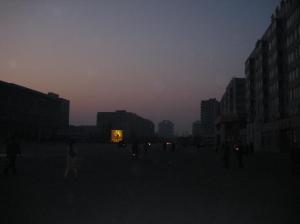 You may have seen satellite photos from space that show North Korea as a great pool of inky blackness – as dark as the ocean around it – wedged between a brightly lit South Korea and China. On the ground, that darkness is all consuming, and the contrast even more striking. A few months after visiting the DPRK, I traveled to Dandong, a Chinese border town just across the Yalu River from North Korea. During the day, two cities of roughly equal size – Dandong in China, Sinuiju in Korea – face each other across the broad river. At night, Dandong, like any other Chinese city, erupts into an explosion of brightness. The Chinese have a love affair with flashing colored lights, and will rig a simple seafood restaurant to outshine the Las Vegas strip. Sinuiju, on the North Korean side, simply disappears. Hardly a flicker can be seen, and you’d think that the shore opposite Dandong was completely uninhabited. What the North Koreans confronted every night with this blazing contrast must think, I can hardly speculate.
You may have seen satellite photos from space that show North Korea as a great pool of inky blackness – as dark as the ocean around it – wedged between a brightly lit South Korea and China. On the ground, that darkness is all consuming, and the contrast even more striking. A few months after visiting the DPRK, I traveled to Dandong, a Chinese border town just across the Yalu River from North Korea. During the day, two cities of roughly equal size – Dandong in China, Sinuiju in Korea – face each other across the broad river. At night, Dandong, like any other Chinese city, erupts into an explosion of brightness. The Chinese have a love affair with flashing colored lights, and will rig a simple seafood restaurant to outshine the Las Vegas strip. Sinuiju, on the North Korean side, simply disappears. Hardly a flicker can be seen, and you’d think that the shore opposite Dandong was completely uninhabited. What the North Koreans confronted every night with this blazing contrast must think, I can hardly speculate.
One day on the bus, Mr. Smooth (the bolder, more self-assured of our two minders) asked me what my impressions were of his country. As a guest, I tried to be diplomatic but honest. After searching for the right words for a moment, I told him that Pyongyang reminded me of China when I first visited there in the 1980s. It’s not a precise fit – even then, China was in the process of opening up – but the similarities were real enough. There was the same uniformity of plain drab clothing, the same propaganda posters and absence of commercial advertising — absence of any commercial activity at all, in fact. On my first trip to China, I told him, our tour group also had two minders in the back of our bus to keep watch on us foreigners. True, we had greater freedom to interact with the Chinese who wanted to change money in front of our hotel, and we could walk a stretch down the main street. But we could hardly wander at will, and the same gulf of incomprehension existed between our world and the Chinese.
Mr. Smooth was greatly intrigued by this comparison. He had never been to China, but many higher-ranking North Koreans have, and there is some level of awareness of the kind of changes that have taken place there, although their exact nature is not widely discussed or understood. In recent years, quite a number of refugees from the DPRK have crossed the border into China to work, and returned to their families bearing tales of a very different world. In fact, it would be fair to say that China’s transformation has had a profoundly unsettling effect on North Koreans’ perceptions of their own lives and range of possibilities. Our minder was incredibly interested to hear about China’s economic reforms, particularly how they got started, and was brimming with all kinds of very rudimentary questions about the conduct of business beyond North Korea’s borders. He wanted to know, for instance, if all companies in the U.S. were owned by the government, and if they were not, did the owners require special government permits to do business? He was amazed and curious to learn that American companies had joint ventures or even their own independent operations in China.
His questions, and my observations, drove home to me how profoundly China had changed in the past 20 years. In particular, it made me realize how many changes had to take place to make it possible for me to meet my wife, who grew up in Beijing. When I first visited, she was one of those schoolgirls wearing a red “pioneer” scarf. In the years that followed, China opened, and she went to college in America and worked on Wall Street. Her world changed, and became part of my own. Sometimes we talk about what it would have been like if we had encountered each other when I first came to Beijing. What would we have said to each other? Could we have believed what life had in store for us? I thought about her as I watched North Korean kids passing by through my bus window, on the other side of that pane of glass. At best, maybe I would have taken her picture. She would have stared back at me, and then we would each go our own way, wondering what the other person was thinking.
Next installment: A truly surreal journey to the gift pavilion of the Great Leader, where we bask in his (virtual) presence.
All photos were taken by the author. Please ask permission before copying.

Great reporting, Patrick.
As an American working in South Korea, your article was phenomenally insightful and totally reinforces the sentiments and ideas about North Korea shared by many of my co-workers. The attitude seems to me very much like post-war Germany, a split much more forced up the oldest generation and only no about second hand by most all others. Fine work.
Thank you for this report. The last paragraph with comparison to the situation in China is most interesting. I hope that 20 years from now we will be able to look back on changes in North Korea that compare to those in China.
Mr. Chovanec, thank you for the fascinating, heartfelt and very well-written travelogue, which I found via the link at Matt Yglesias’s blog.
A question and comment:
1) Is it possible that Pyongyang is not really short of electricity at night, but in fact is under constant air raid warning and government-imposed blackout restrictions?
2) Your description of how the government prevented you from meeting North Koreans reminds me very much of George Kennan’s memoirs of his days living as a foreign diplomat in Stalinist Russia.
In response to your first question, whether Pyongyang is under air raid blackout, my guess is no, because state monuments such as the triumphal arch and the Juche Tower are very well lit at night (blindingly so), even while the rest of the city is plunged in darkness. In fact, if you look at the photo accompanying my description, for instance, the city street is entirely dark except for a big propaganda billboard in the background.
your blog makes serious reading. thank you.
I just stumbled upon this blog today. I can’t stop reading. Really great reporting.